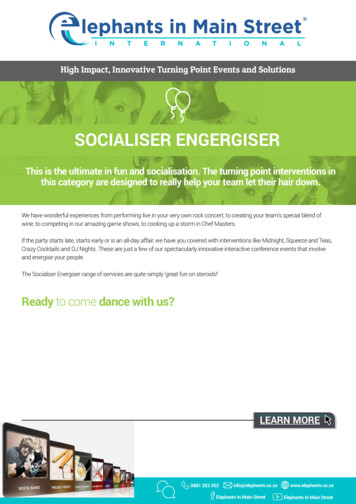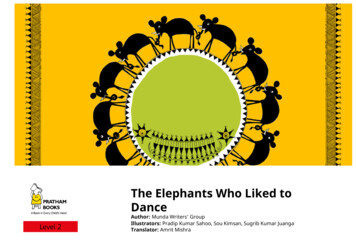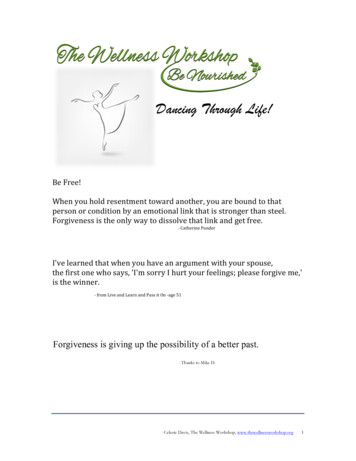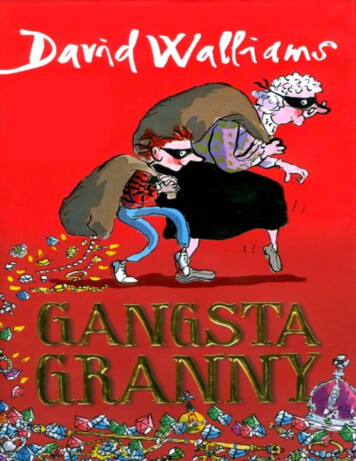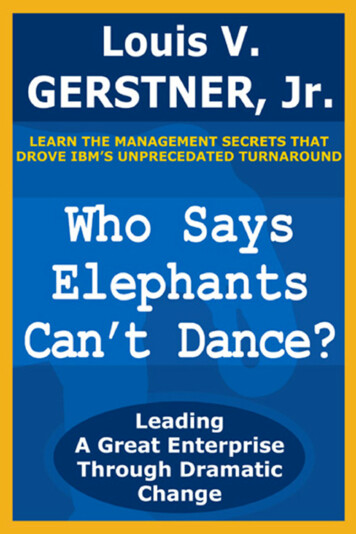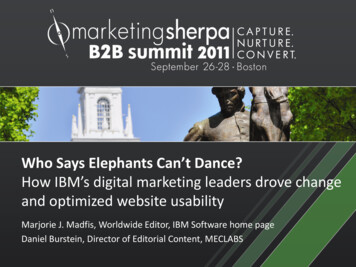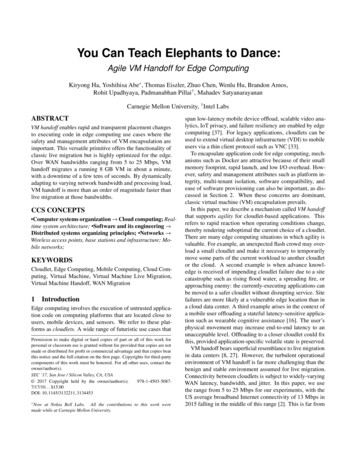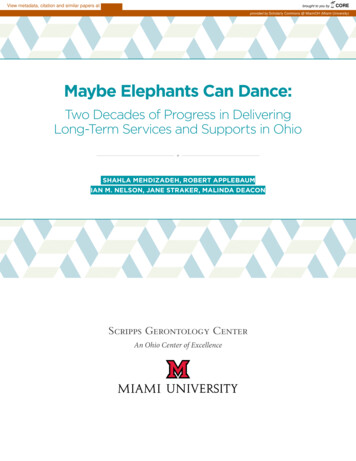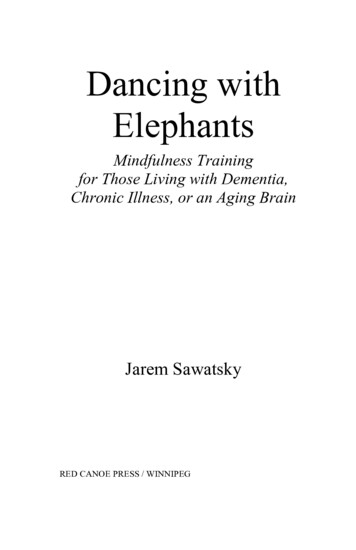
Transcription
Dancing withElephantsMindfulness Trainingfor Those Living with Dementia,Chronic Illness, or an Aging BrainJarem SawatskyRED CANOE PRESS / WINNIPEG
Copyright 2017 by Jarem SawatskyAll rights reserved. No part of this publication may be reproduced, distributed ortransmitted in any form or by any means, without prior written permission.Red Canoe Press266 WinnipegWinnipeg, Manitoba, R3G1X3, Canadawww.redcanoepress.comDancing with Elephants: Mindfulness Training for Those Living with Dementia,Chronic Illness or an Aging Brain / Jarem SawatskyHow to Die Smiling Series 1ISBN 978-0-9953242-0-6
Get 5-Part Video Series FREESign up for Jarem’s no-spam newsletter and get a freecopy ofA More Healing Way:Video Conversations on Facing Diseasefeaturing Jon Kabat-Zinn, Patch Adams, Lucy Kalanithi,John Paul Lederach and Toni Bernhard.Hosted by Jarem Sawatsky ( 200 value).Details can be found at the end of Dancing withElephants.Reading Guide for Dancing With Elephants (great forindividuals and book clubs) available at:www.jaremsawatsky.com/dancing-guide3
JAREM SAWATSKYReviews beautifully models a way to dance in the galeof full catastrophe, to celebrate life, to laughwith it and at himself - JON KABAT-ZINN, national bestselling author of FullCatastrophe Living a powerful example of the art of real happiness. This inspiring story reminds us just howessential it is to bring lovingkindness into everystep of life, no matter how difficult the path.-SHARON SALZBERG, New York Times bestsellingauthor of Real HappinessLife can be tough and it's even tougher withoutthe ability to find humor. When life seems to befalling apart, Jarem Sawatsky's reminds us thatlaughter is what we need to not take ourselvestoo seriously.-JEN MANN, New York Times bestselling authorof People I Want to Punch in the Throat beautiful and inspiring full of humor andwisdom about the pain of loss in our life,-JEAN VANIER, national bestselling authorof Becoming Human4
CONTENTSFacing Elephants . 7Part I Reverence for LifeEmbracing the Hard Things . 21Replacing Fear with Love . 27Letting Go . 35Celebrating Everything . 39Living the Life You’ve Got with Jon Kabat-Zinn . 43Part II True HappinessLiving Beauty Awake . 55Embracing Dustness. 65Walking the Urban Pilgrimage . 71Loving a Puppy . 77Diving into an Ocean of Gratitude with Patch Adams . 81Part III True LoveResponding to a Disease with a Circle . 91Dying and Mourning with Love . 101Loving Our Ancestors . 107Playing with Children . 115Being Disarmed by Joy with Lucy Kalanithi . 119Part IV Loving Speech and Deep Listening5
JAREM SAWATSKYRefusing to Battle My Disease . 127Naming Your Own Way . 135Making Friends with Darkness . 141Remembering Forgetting Is OK. 145Breathing Anger . 149Practicing Awe During Winter’s Creep with John PaulLederach . 157Part V Nourishment and HealingEmbracing Weakness . 165Falling Mindfully . 171Valuing Your Life . 177Eating like a Buddha . 182Developing a Family Health Plan . 187Mandela Gardening . 193Practicing Self-Compassion with Toni Bernhard . 199Last Words . 207Free Video & Audio Series - A More Healing Way . 211Please Leave a Review. 212Acknowledgements . 215About the Author . 217Also by Jarem Sawatsky . 219Dedication . 2236
Dancing with Elephants{1}Facing ElephantsDearest Elephant Dancer,I know nothing about elephants nor dancing.And yet, this is a training manual and love letterfor elephant dancers like yourself.Facing elephants is something we often avoid. Mostof us have elephants hidden in our closets, or hidden inplain sight. These elephants are our big, unacknowledgedfears.What are your elephants? What do you fear? Whogave you these elephants? How can you learn to love anddance with your elephants?In this book, I serve as your guide in teaching the artof dancing with elephants. One of my big elephants isHuntington's disease—once called the dancing disease!It's an incurable, genetic, progressive, fatal brain disease.It is kind of a combination of Parkinson's, Alzheimer'sand Schizophrenia. Just picture an elephant with this7
JAREM SAWATSKYcombo! That picture makes me laugh now. But I havenot always been laughing.I’ve never really known life without Huntington’sdisease lurking somewhere in the corner. Huntington’s isgenetic and so is passed down from generation to generation. It is a slow train wreck of a disease, sometimeslasting up to 25 years from first symptoms to death. Inthe olden days people would say, "Stay away from thosefamilies—they go crazy as they age and it is not pretty.”When I was a child, my grandmother’s generation hadHuntington’s, as did some of our more distant relatives.Several of them were put in asylums because not muchwas known about the disease. I was told to not worrybecause a cure would surely be found by the time I developed it, if I ever did. When I was in my teens, it wasmom’s generation’s turn–my mother had it, as did all hersiblings except for two brothers, one of whom wasadopted. Huntington’s seemed like a massive earthquakethat left mostly rubble behind. As a teen, I was part ofthat rubble. When I started university, I began to focuson conflict and peace studies. I was interested in findingmore healing ways to deal with injustice, harm, fear, andviolence. By grace, I fell in love with Rhona Hildebrand,an elementary school music teacher. Before we weremarried, we had to have some careful discussions aboutHuntington’s disease—yes, you can meet my mom butshe is not well and can be quite explosive. No, I guessshe doesn’t treat me like a son I told Rhona she should8
Dancing with Elephantsconsider seriously whether she wanted to marry into aHuntington’s disease family. I nervously awaited her response. In hindsight, I learned I had two things workingin my favour: 1) She was raised by people who modeledloving through life’s ups and downs and 2) I am a verygood kisser and Rhona was hooked. So we got married.Rhona said we needed to include “in sickness and inhealth” in our vows. And so we did. After a couple ofyears of marriage, we moved to Virginia for a year sothat I could earn a master’s degree in conflict transformation. During that year, we got pregnant with identicaltwin girls. We moved back to Canada, where our wonderful daughters, Sara and Koila, were born. I taughtconflict studies at two universities in Winnipeg. Teaching turned out to be a great fit, but I knew that if Iwanted to continue to teach at the university level, Iwould need to get my doctorate. So I applied and got afull scholarship to the University of Hull in England. Wemoved there when the girls were three. It was in Englandthat I started my research into communities that practiced healing justice. I traveled around the world, visitingThich Nhat Hanh’s Buddhist community in France; Hollow Water, an Indigenous community in Canada; and theIona Community, a Christian community based in Scotland. These places are living examples of community lifewhere injustices are addressed with healing and love rather than punishment, judgment, and fear. During thistime, my mom died from Huntington’s disease at the age9
JAREM SAWATSKYof fifty-eight. We had to fly back from England for herfinal days and the funeral. Two years later, I completedmy studies and was re-hired as Assistant Professor atCanadian Mennonite University. I published twobooks—one about research into restorative justice andpeace-building that I had written in Virginia and the other about the three communities of healing justice that Ihad studied in England. My career as a teacher, researcher, and author was going very well. I got a governmentgrant to allow me to continue travelling the worldsearching for communities of healing justice. The girlswere in school and Rhona was back at work half time.Life was good. But we knew that because my mom hadHuntington’s disease, I had a 50/50 chance of getting it.My mother’s main coping mechanism was to deny thatshe even had the disease. This left too many elephantslurking in the corners. There was a DNA blood test Icould take that would tell me if I had inherited the genefor the disease. My mom could have had the test done adecade sooner than she did. While denial may have provided her some comfort, it made it profoundly difficultfor any of us to support her on the journey. I wanted tochart a different path. First, I applied for early promotionat work. Once I was approved, both me and my brotherhad the testing done. I was positive. He was not. I woulddevelop the disease. My daughters now had a 50/50chance of having the disease.10
Dancing with ElephantsFor me, the news was both shocking and not shockingat all. I had always felt like I would get the disease. Thatinsight provoked me to enjoy life in the present. However, having a doctor tell you that you will get this diseaseis, of course, different than listening to your own innervoice. The genetic counsellor had to make sure I wasn’tsuicidal over the news. When she asked what we weregoing to do next, I said, “We will throw a Movers &Shakers party with friends to welcome the next part ofour journey.” She asked if I was kidding. You can readabout the party in Chapter 5 – Celebrate Everything.The same day we learned my diagnosis, we told ourgirls and went on a short family vacation to process it.The doctors could not give me a timeframe for the onsetbut I started to visit a neurologist every eight months fora checkup. Four years later, in 2014, I began havingsymptoms. When it was time to see the neurologistagain, I put together a self-assessment, comparing myselfto the previous year. Rhona added to the list and weshared it with the neurologist and the social worker fromthe Huntington Disease Society. Here are some highlights from that list.Movement (body): stiff ankles progressively poor typing skills involuntary foot and toe movement finger movement elbow movement, lots of spilling11
JAREM SAWATSKY decreased spatial awareness – knocking intothingstingling sensation in the top of headpainful sensitivity to loud noisesringing in my earssome swallowing problemsnight-time leg twitchesmore sick days from work than ever beforeCognitive (mind): difficulty moving to the next task at work inability to multitask very distractible, can’t keep focus very long hard time deciding on priorities tend to get an idea in my head, then get fixedon it altered sense of time—it seems to move veryslowly, and I am more impatient hard to remember to follow through on short,easy tasks overwhelmed by email, and don’t open mostof it harder time making decisions hard to sustain complex research exploration slowed mental functioning loss of ambition—hard to self-motivate orinitiate hard time remembering short grocery list hard time remembering/accessing the word Iam looking for tend to take on job assignments at work andthen not get work done foggy brain12
Dancing with ElephantsPsychiatric (emotional & relational) depression don’t seem to feel fear in situations I used tofeel fear (e.g. heights) hard to move out of anger tend to be easily irritable avoid social settings constantly feel like a failure at work increasingly tired in the evenings and likelierto stay home and not relate to others tend to care less about mistakes loss of spontaneity – prefer to know what iscomingRhona and I met with the neurologist and a socialworker. After a bunch of discussion, the neurologist toldus that it was time for me to quit work. This was in earlyJuly. Again, we went straight on vacation—a road tripacross Canada—lots of time to process our new path,again.On the advice of friends, we added a golden lab puppy named Kobi to our family. Sara and Koila are 15now. Kobi is two. And I am literally stumbling my wayinto learning about loving, letting go, and living in thepresent moment.I understand the agony, pain, and struggle of havingyour world turned upside down by disease and aging. Ihave watched Huntington’s move through three generations. I look into the eyes of my daughters with the fullknowledge that there’s a 50/50 chance that they too have13
JAREM SAWATSKYHuntington’s, passed on by me. After they turn 18, theywill need to wrestle with whether or not to get the DNAtest done. It is possible this disease may take anothergeneration, my girls.This is hard for all of us. In many ways, I have hadlots of advantages in life. I have made studying conflictand healing my life’s work. I do not want agony to be themain story of my life. I think agony, on its own, is toxic.I do not want to pass agony, fear, or violence onto Sara,Koila, or Rhona. So I have been experimenting on myself to find a healing way to face disease.I am two years into these experiments and explorations. I will share my results with you. To help youunderstand the way I am trying to live well with disease,I need to first share the stories and the wisdom of someof the people who have influenced me the most on thisjourney.When you find out that you are dying from an incurable disease, a kind of clarity can emerge. It is the clarityto distinguish between what matters and what does notmatter. Having four university degrees and having experienced three generations of a debilitating disease, I hada lot of sorting to do. This book chronicles what I see asimportant. It is my cheat sheet for facing disease andaging in a healing kind of way.When I had to “retire” at age 41 from my work as auniversity professor, I had hundreds of books. I gaveaway almost all of them. I saved the handful I thought14
Dancing with Elephantsmight be helpful for me in learning the art of dancingwith elephants.The author with the greatest number in my little library is Zen Buddhist Master Thich Nhat Hanh. Whilehe is not quoted much this book, Thay—as his studentscall him—lies at the heart of it. Thay is responsible forbringing a revitalized Engaged Buddhism to the west. Hewas nominated for a Nobel Peace Prize by Martin LutherKing Jr. I had the privilege of spending time at his community, Plum Village, as part of my research on healingjustice. Thay is an author of more than one hundredbooks. I find his writing and speaking deeply valuable. Itis inspiring but also very concrete and practical. I wasdeeply shaped by Thay’s focus on practicing wisdom ineveryday life and living that wisdom in a community. Inthis book, I try to maintain this focus: true wisdom, livedin the everyday, supported in a community. The summerI was at Plum Village with my family, Thay taught thefive mindfulness trainings. Each of the five parts of thisbook reflects one of these trainings.Each section also includes an interview with a leaderin the field of finding more healing ways of living. Thefeatured teachers include the following:Jon Kabat-Zinn, is the author of 10 books on mindfulness, trauma and health. He is known for mindfulnessbased stress reduction (MBSR) trainings which morethan 16,000 people have successfully completed. MBSRwas designed to develop relaxation and calm self-15
JAREM SAWATSKYawareness, a reliable foundation for facing the "full catastrophe" of stress, pain, and illness—indeed, of lifeitself. In Chapter 6 Jon Kabat-Zinn dares us to focus onliving now, rather than being paralyzed by the life wecannot live.Patch Adams, M.D. who was made famous by the hitmovie starring Robin Williams. Patch has been workingon building a model hospital, modelled as an ecovillagewhere doctors and patients live together and where thedoctor and the janitor get paid the same salary. Patch estimates he has been present at more than 10,000deathbeds. In my interview with him in chapter 11, hetalks about dying well and living well.Lucy Kalanithi wrote the bestselling book WhenBreath Becomes Air with her 36-year-old neurosurgeonhusband, Paul, as he was dying of stage IV metastaticlung cancer. Lucy, who is also a medical doctor and professor, spoke with me about true love in the face ofdiseases like cancer.John Paul Lederach is the author of more than 22books on conflict transformation, peace-building, andhealing. John Paul—my former professor—and I discusshow his professional life and his faith has helped andhindered him in supporting his wife, Wendy, who hasParkinson’s disease.Toni Bernhard was a law professor at the Universityof California-Davis for 22 years until some fibromyalgia-like illnesses forced her to retire. In chapter 29, Toni16
Dancing with Elephantsand I discuss the three books she has written since, including How to Live Well with Chronic Pain and Illness.The rest of the book offers glimpses of my wrestling,laughing, and stumbling my way into healing. Not thekind of healing that takes away the disease but the kindof healing that awakens the heart to love. I call this dancing with elephants because dancing is a playful way ofengaging that which we fear most. Those who know mewell know that playfulness is a major practice for me, asis the intentional use of humor. Suffering is real andmust be faced head-on. But suffering alone is notenough. On the other side of suffering can be joy—andalso more suffering. We must learn to dance with both.Our culture offers abundant advice on how to achievefinancial and career success, but there are very fewbooks on how to embrace the downward path of losingyour mind. We have success tips for leaders, but almostno “success tips” for the billions of us facing disease,dementia, and aging. This book is for those billions. Together we will explore the art of dancing with elephants.I invite you to join me in this dance.17
Dancing with ElephantsPart IReverence for Life19
{2}Embracing the HardThingsOn Avoiding the Hard ThingsDo prayers ever piss you off? Sometimes theypiss me off. In my teens and twenties, I was awilderness guide, leading group canoe trips.Sometimes participants on these trips would pray that itwouldn’t rain. Even in my teens, I knew this made nosense. Sometimes I would prod.“Do you want the trees and animals to die? They needrain.”“No,” they would say. “We just don’t want it to rainon us.”“Oh, so you want it to rain on the other groups I takeout this summer, but not your group?”“No,” they would say. “God can make it rain on thetrees and animals but not the people.”21
JAREM SAWATSKYI already realized as a teen that it requires substantialmental (and sometimes theological) gymnastics for people to be able to justify a view of the world in whichuncomfortable or unpleasant things shouldn’t happen.On the Way We Ride the WaveThis fall, I returned to that same wilderness of CanadianShield country. It felt like coming full circle. Crossingpaths with my younger self, I was reminded of the wisdom I could receive only by listening to the heartbeat ofthe wild. The temptation to try and insulate oneself fromthe hard things remains both common and understandable, but I still don’t want to run from the storm. I don'twant to run from the hard things. Healing is not the absence of the storm. Healing is the way we ride.Driving alone on the prairies after going to the funeralof a young man, and thinking about my own chronic illness and about rain, I wrote this poem:Nobody Wants the RainEverybody wants green sceneryNobody wants the rainEverybody wants food on the tableNobody wants the rainEverybody wants the colourful rainbowNobody wants the rainEverybody wants water in their bodiesNobody wants the rain22
Dancing with ElephantsI went to the prairie,The Expander of HorizonsTo ask about the rainI stood on the edge of the worldAnd watched the rain coming all aroundAnd the prairie proclaimed a visionEach time the gift of rain was offeredthe people ran in fearHeart’s fear perverts darkness into evilMissing the gift of life hidden in the cloudLet it rain down, let it rain downLet it rain down on meEverybody wants green sceneryNobody wants the rainEverybody wants food on the tableNobody wants the rainEverybody wants the colourful rainbowNobody wants the rainEverybody wants water in their bodiesNobody wants the rainI went to the mountainThe Giver of WisdomTo ask about the rainI knelt on ancient rocksFifty billion years awake23
JAREM SAWATSKYand the rocks spoke to meThe rain shapes and molds usand turns us into sandThese rain-shaped rocksFeed the earth as their dust becomes soilThe mighty mountains are transformedBy but a tiny drop of rainLet it rain down, let it rain downLet it rain down on meEverybody wants green sceneryNobody wants the rainEverybody wants food on the tableNobody wants the rainEverybody wants the colourful rainbowNobody wants the rainEverybody wants water in their bodiesNobody wants the rainI went to the oceanThe Alpha and OmegaTo ask about the rainI sat on the ocean’s edgeAs but a tiny grain of sandAnd the ocean questioned meWhere is my beginning andwhere is my end?Ocean’s edge is hard to find24
Dancing with ElephantsOn shore? In sky? Inside my body?The ocean’s end is its own beginningLet it rain down, let it rain downLet it rain down on meWe cannot learn to revere life if we cannot wrap ourhearts around the idea that suffering exists. The art ofdancing with elephants is not the elimination of suffering. We don’t kill the elephant. We learn to dance withit. All living beings suffer. To revere life, we cannot remain in denial but must understand that suffering anddeath are inevitable. This truth is not the end of the storybut it is a necessary starting point on this journey.Once we become comfortable with the idea that suffering exists, we need to learn to let go of fear andreplace it with love. This is the focus of the next chapter.25
{3}Replacing Fear withLoveThe next step in learning to dance with elephantsis to learn to overcome fear. Fear lies at the rootof much unnecessary suffering. Overcoming fearwill dissolve some kinds of suffering. The suffering thatremains needs to be accompanied by love.On October 27, 2010, I tested positive for the gene forHuntington’s. This meant that I would get the diseasethat had killed my mother and a number of her relatives.Among other things, this disease is a long, slow degeneration to death. Through this disease, over the course ofabout twenty years, I get to practice the spiritual discipline of letting go of everything that I had thought made27
JAREM SAWATSKYme human: eating, walking, sitting still, control of muscles, speaking.Exactly one month after testing positive for the Huntington’s gene, I was to preach in the small Christianchurch community where I grew up. I agonized aboutwhat to say. One of the practices that was giving me joyand freedom at that time came from a meditation that Ihad learned in Plum Village. Fresh with the perspectivethat I should speak out of my experience (rather thanprimarily out of my thinking), I modified a meditation onbones to use language that more of my Christian friendswould understand. That Sunday, I told the communityabout my diagnosis. I told them that if there is an elephant in the room that won’t go away (like Huntington’s)at least we can learn to dance with it. And I taught themthe practice that was helping me learn how to dance withthe elephant. It is a practice of transforming fear into joyful dancing, called Corpse Prayer. It’s not an easypractice but it does seem to bear good fruit in me andothers. And so I offer this practice to you as a tool thatmay help you begin to dance with your own elephant.Corpse PrayerI want you to take a moment to imagine the last threeminutes of your life. Where will you be? What will yoube doing? Who else is there? Will it be sudden? Will yoube suffering? Will you have suffered for a long time al28
Dancing with Elephantsready? What emotions and thoughts will you be experiencing?Imagine the scene as if you were watching it on a TVscreen. Notice the emotions that arise within you as youwatch. Do not identify yourself with these emotions, butrecognize that they are rising within you. If these emotions are primarily fear and anxiety, then you know thisis a tender topic that needs your careful attention. Let uspractice loving yourself at the point of your death.As you picture yourself dying, try saying thesephrases:Be not afraid.I give thanks to God who created all things good.In Christ, all things hold together.I am not entitled to life without death.I embrace sacred life. I embrace sacred death. I embracethe growing and crumbling in between.Smile at yourself in the silence Now picture the moment your body is being buried.Think of that moment when your body returns to theearth, when your coffin is lowered and reaches the end ofits journey.Picture yourself there. See the movie. Notice the emotions that arise within you. Do not identify yourself withthese emotions but recognize that they are rising withinyou.As you picture yourself dead and just starting to decay, try saying these phrases:29
JAREM SAWATSKYBe not afraid.I give thanks to God who created all things good.In Christ all things hold together.I am not entitled to life without death.I embrace sacred life. I embrace sacred death. I embracethe growing and crumbling in between.Smile at yourself Now picture your body two years after your death,when your body is decomposing and the worms are eating your flesh.As you picture yourself dead and well decayed, trysaying these phrases:Be not afraid.I give thanks to God who created all things good.In Christ all things hold together.I am not entitled to life without death.I embrace sacred life. I embrace sacred death. I embracethe growing and crumbling in between.Smile at yourself in the silence Now picture your body eighty years later, when allthat is left is bone, or move even further into the futureand watch as even your bones turn to dust. Attend toyour emotions.As you picture yourself dead and turning to dust, trysaying these phrases:Be not afraidI give thanks to God who created all things good30
Dancing with ElephantsIn Christ all things hold together.I am not entitled to life without death.I embrace sacred life. I embrace sacred death. I embracethe growing and crumbling in between.Smile at yourself in the silence For me this practice is freeing, even humourous. If inthe end all is dust, I can let go of some of my fear, anxiety, and self-absorption. If in the end all is dust, then nowis the time to enjoy, to play, to love. The fruits of thiskind of freedom are countless.Transforming Road RageOf course, life is still full of struggles. But replacing fearwith love helps us as we face them. Let me give just onetaste of the fruits of living with less fear.One day last year, I was driving our car in downtownWinnipeg, heading out with my wife, Rhona, on a lunchdate. From behind us, we could hear a horn blaring.Some seconds later, I stopped for a red light and saw ayoung man in a large, shiny truck with extended suspension in the next lane. I looked up at him. He was yellingand glaring at me. In the past, I probably would havebeen afraid and would have suppressed my fear until itcame out later, directed at some other target. But thistime, things unfolded differently. I glared back at him.As he struck different poses, I copied them. I saw hispassenger window was open, so I rolled down my driv31
JAREM SAWATSKYer’s side window. I think I wanted to hear what he wassaying. But before I made any plan or intentional decision, I found myself calling out to him, “Parlez-vousFrancais?” politely asking if he speaks French! On myright, I saw my wife instinctively pretending to be a deafperson reading an imaginary book. On the other side ofme was the young man in the big truck, full of rage. After an awkward silence, he said “No,” and gave a bigsigh. He de-escalated and backed right down and so didI. Who knew the language of love (French, I mean) hadthe power to transform fear and road rage into humour.After my wife’s disappearing act ended, her fear turnedto laughter. “Did you just pretend to speak only French?”she asked. “Yes,” I answered, though in truth I speakvery little French at all.I know this was probably not the most honest or mostloving response. But responding with playfulness ratherthan fear transformed the situation. When you let go offear, a new vista starts to emerge. This new vista is ameadow, with plenty of room to explore, to play, tolaugh, and to love. Perhaps the Corpse Prayer can helpfree you. Or if that doesn’t work, try laughing.There is much healing we can do when fear is replaced by love. Fear makes us defend life, like somepossession, at all costs. Love provides a way t
dance with your elephants? In this book, I serve as your guide in teaching the art of dancing with elephants. One of my big elephants is Huntington's disease—once called the dancing disease! It's an incurable, genetic, progressive, fatal brain disease.File Size: 1MB
